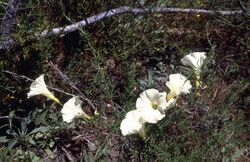Biology:Calystegia stebbinsii
| Calystegia stebbinsii | |
|---|---|

| |
| Scientific classification | |
| Kingdom: | Plantae |
| Clade: | Tracheophytes |
| Clade: | Angiosperms |
| Clade: | Eudicots |
| Clade: | Asterids |
| Order: | Solanales |
| Family: | Convolvulaceae |
| Genus: | Calystegia |
| Species: | C. stebbinsii
|
| Binomial name | |
| Calystegia stebbinsii Brummitt
| |
Calystegia stebbinsii is a rare species of morning glory known by the common name Stebbins' false bindweed. It is endemic to the Sierra Nevada foothills of California , where it is known from only two spots in El Dorado and Nevada Counties. It grows in unique habitat in chaparral on gabbro soils.[4] It is a federally listed endangered species.[2]
Description
Calystegia stebbinsii is a perennial herb producing climbing, white haired, vine-like stems approaching a meter in maximum length. The leaves are up to about 5 centimeters long and palmate in shape with 7 to 9 long, narrow lobes; the distinctive shape of the leaves make the plant easy to identify among the morning glories native to the region.
The inflorescence bears flowers atop long peduncles, each flower about 3 centimeters wide and white or cream-yellow in color, sometimes tinted with pink. They are pollinated by bees and other insects.[5] Like many other chaparral plants, this species has seeds which are stimulated to germinate by exposure to wildfire.[4][1] It also reproduces via rhizome.[5]
Conservation
The plant's type specimen was collected by G. Ledyard Stebbins in 1970 outside of Placerville, California.[3] The species was described to science and named for him in 1974.[6] The plant is known from only two locations, each containing a scattering of occurrences.[3] Both locations are on the Pine Hill intrusion, a section of gabbro-based rock that oozed as magma into the surrounding rock and then solidified there, eventually becoming exposed as the softer rock around them eroded away.[3] This gabbro intrusion yields red-colored soil that is rich in heavy metals, and some plants are adapted to this kind of substrate.[3] C. stebbinsii grows on the gabbro soil as well as the similar serpentine soil that can also be found in the intrusion.[3] Other species are completely limited to the gabbro sections.[3] The Pine Hill Ecological Reserve was established to protect these unique and often rare plant species.[5]
At the time it was placed on the endangered species list, at least one third of the known occurrences of the plant had been destroyed, mostly by development of its habitat.[3] Most of the sites that still existed were in danger of destruction.[1][3] With destruction and fragmentation of the habitat come associated activity such as road construction, trash dumping, off-road vehicle use, and herbicides.[1]
The plant does not tolerate shade, and when the brush around it grows too high and shades it out, it does not survive.[5] This suggests it requires disturbance, such as wildfire, to clear the overgrowth.[3] Fire suppression is detrimental.[1] Protected and managed areas of the habitat undergo controlled burns.[5]
References
- ↑ 1.0 1.1 1.2 1.3 1.4 NatureServe (5 May 2023). "Calystegia stebbinsii". Arlington, Virginia: NatureServe. https://explorer.natureserve.org/Taxon/ELEMENT_GLOBAL.2.144650/Calystegia_stebbinsii.
- ↑ 2.0 2.1 "Stebbins' morning-glory (Calystegia stebbinsii)". U.S. Fish & Wildlife Service. https://ecos.fws.gov/ecp/species/3991.
- ↑ 3.0 3.1 3.2 3.3 3.4 3.5 3.6 3.7 3.8 3.9 USFWS (18 October 1996). "Determination of endangered status for four plants and threatened status for one plant from the central Sierran foothills of California". Federal Register 61 (203): 54346–54358. 61 FR 54346
- ↑ 4.0 4.1 "BLM Profile". http://www.blm.gov/ca/pa/ssp/plants/calystegia_stebbinsii.html#.
- ↑ 5.0 5.1 5.2 5.3 5.4 Hinshaw, G. Pine Hill Preserve Management Plan. July 2008.
- ↑ Brummitt, R. K. (1974). A remarkable new species of Calystegia (Convolvulaceae) from California. Kew Bulletin 29:3 499–502. JSTOR 4107994 doi:10.2307/4107994
External links
Wikidata ☰ Q148359 entry
 |



